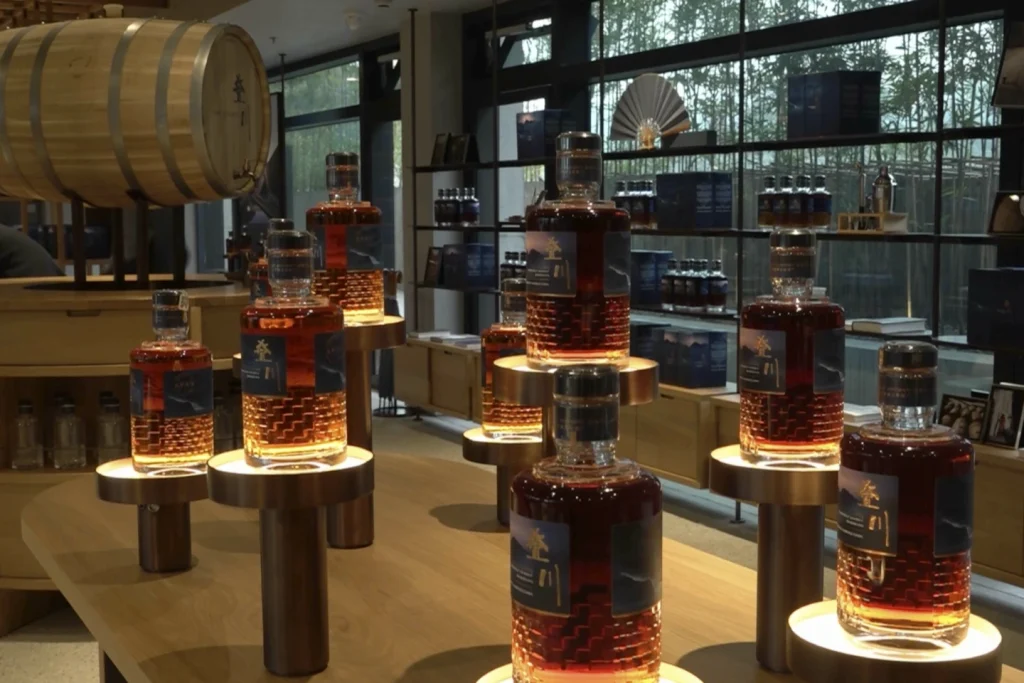The emergence of a distillery in southwestern China, owned by Pernod Ricard and situated at the UNESCO World Heritage site Mount Emei, marks a significant shift in the preferences of young Chinese consumers towards whisky as opposed to the traditional baijiu liquor.
This shift is indicative of the changing tastes and preferences of the younger generation in China, as they embrace new and international alcoholic beverages.
The distillery’s investment of over $100 million in the production of pure-malt whisky, known as The Chuan, signifies the growing demand for whisky in China.
Pernod Ricard has strategically combined traditional whisky-making techniques with Chinese characteristics, such as locally grown barley and oak barrels sourced from the Changbai mountains in northeastern China.
This fusion of traditional and local elements aims to cater to the unique and evolving palates of Chinese consumers.
Yang Tao, the master distiller at the distillery, highlights the significance of Chinese terroir in the production of The Chuan.
He emphasizes the exceptional and unique environment for aging, including the renowned water source at Mount Emei, which is known for its top-notch mineral water.
This attention to detail and emphasis on the distinct qualities of the Chinese terroir reflects the commitment of Pernod Ricard to create a product that resonates with the local consumers.
The introduction of The Chuan and the establishment of a distillery in a culturally significant location like Mount Emei not only signifies a shift in consumer preferences but also reflects the growing influence of international spirits in the Chinese market.
As the younger generation in China becomes more exposed to global trends and experiences, their preferences for alcoholic beverages are also evolving.
This trend presents an opportunity for international companies like Pernod Ricard to capitalize on the changing landscape of the Chinese alcohol market.
Furthermore, the investment in a distillery at Mount Emei not only showcases Pernod Ricard’s commitment to the Chinese market but also highlights the potential for growth and innovation in the country’s spirits industry.
By integrating local elements and traditional techniques, Pernod Ricard is not only appealing to the evolving tastes of Chinese consumers but also contributing to the development of the local spirits industry.
In conclusion, the emergence of a distillery in southwestern China and the launch of The Chuan by Pernod Ricard symbolize the changing preferences of young Chinese consumers towards whisky.
This shift presents an opportunity for international companies to tap into the growing demand for international spirits in China.
The fusion of traditional whisky-making techniques with Chinese characteristics reflects a strategic approach to cater to the evolving tastes of Chinese consumers, while also contributing to the development of the local spirits industry.

As the Chinese market continues to embrace international influences, the future of whisky in China looks promising, with Mount Emei poised to become a significant player in the country’s spirits industry.
The global landscape of whisky consumption has been undergoing a significant transformation, with China emerging as a key player in the market.
This essay aims to explore the burgeoning popularity of whisky in China, shedding light on the factors contributing to its rise and the implications of this trend.
From the rapid growth of distilleries to the changing consumer preferences, the evolution of whisky in China represents a compelling intersection of culture, economics, and individuality.
Whisky, an age-old spirit with deep-rooted traditions, has found a relatively recent foothold in the vast expanse of China.

The emergence of over 30 whisky distilleries in the mainland stands as a testament to the increasing demand for this revered beverage.
According to data from the whisky website Billion Bottle, the landscape of whisky production and consumption in China has experienced a remarkable surge in recent years.
The statistics paint a compelling picture of whisky’s ascent in China. IWSR, a prominent beverage market analysis firm, reports a substantial 10% compound annual growth rate in whisky consumption from 2017 to 2022.
Projections by market research provider Euromonitor International indicate that this growth trajectory is poised to continue, with sales volume expected to maintain double-digit expansion through 2028.
Such robust growth has captured the attention of industry leaders and analysts, who recognize the immense potential for whisky within the Chinese market.
Alexandre Ricard, chairman and CEO of Pernod Ricard, underscores the promising trajectory of whisky in China, emphasizing its rapid and robust development.
He notes the discerning taste of Chinese consumers, particularly for malt whisky, signaling a notable shift in preferences and a growing appreciation for the complexities of this spirit.
Additionally, Raymond Lee, founder of the Single Malt Club China, offers valuable insights into the societal and economic factors driving whisky’s popularity.
As China’s economy continues to flourish, there is a palpable inclination towards individuality, with whisky serving as a symbol of personal expression and discernment.
The increasing prevalence of whisky consumption in China represents a profound cultural and economic shift. It reflects not only evolving taste preferences but also the broader societal changes accompanying economic prosperity.
As personal incomes rise and individuality becomes a focal point, the allure of whisky as a sophisticated and distinctive beverage gains traction.
The sentiments expressed by Sylvia Sun, a young professional in the music industry, encapsulate the captivating allure of whisky, with its lingering taste and immersive experience resonating deeply with consumers seeking unique sensory encounters.
In conclusion, the burgeoning popularity of whisky in China signifies a multifaceted evolution, intertwining cultural, economic, and individualistic facets.
The rapid proliferation of distilleries, coupled with the discerning palate of Chinese consumers, underscores the transformative nature of this trend.
As whisky continues to carve its niche in the Chinese market, it serves as a compelling emblem of personal expression and sophistication, reflecting the dynamic interplay between tradition and modernity.
The emergence of whisky in China not only enriches the global whisky landscape but also offers a compelling lens through which to understand the evolving cultural and economic dynamics of a burgeoning market.

The global whisky industry has experienced a significant surge in demand in recent years, and one of the driving forces behind this phenomenon is the changing consumer landscape in China.
According to industry veteran Lee, who boasts over 35 years of experience in the field, the whisky boom in China can be largely attributed to the increasing openness of younger Chinese individuals to Western cultures and lifestyles, a stark departure from the attitudes held by their parents’ generation.
It is noteworthy that more than half of China’s whisky consumers fall within the age bracket of 18 to 29 years old, as revealed by an analysis based on data from the e-commerce channel of Billion Bottle, a platform with a user base exceeding 2 million.
This demographic trend underscores the profound impact of the younger generation on the whisky market in China.
Lee’s observations shed light on the evolving attitudes and behaviors of young Chinese consumers. He notes that the country has become increasingly open, with growing opportunities for individuals to travel abroad and immerse themselves in diverse cultures.
As a result, this exposure has cultivated a sense of curiosity and openness to new experiences among the younger demographic.
They are more willing to venture beyond the confines of traditional Chinese customs and embrace novel elements from the Western world.
In particular, Lee emphasizes the newfound courage of young Chinese consumers to explore unfamiliar territories and experiment with new products.
When confronted with the opportunity to try something novel, such as whisky, they are quick to recognize its stark divergence from China’s traditional baijiu.
This recognition, coupled with their receptiveness to new experiences, has facilitated a greater acceptance of whisky within the Chinese market.

The implications of this cultural shift are profound, as they signify a departure from the entrenched norms and preferences that have historically shaped consumer behavior in China.
The younger generation’s receptivity to Western influences has not only expanded the market for whisky but has also contributed to a broader cultural exchange between East and West.
From a broader perspective, the whisky boom in China serves as a testament to the dynamic interplay between globalization, cultural exchange, and evolving consumer preferences.
It reflects the transformative impact of cross-cultural interactions, as well as the profound influence of generational shifts on the consumption patterns of a society.
In conclusion, Lee’s insights into the whisky boom in China underscore the transformative impact of cultural openness and generational change on consumer behavior.
The increasing receptivity of younger Chinese individuals to Western cultures and lifestyles has not only fueled the demand for whisky but has also facilitated a broader exchange of cultural influences.
As China continues to embrace new cultural horizons, the whisky industry stands as a compelling example of the evolving dynamics of global consumer markets.

In summary, the whisky boom in China is a testament to the transformative power of cultural exchange and generational shifts.
As the younger generation embraces Western influences, the whisky industry stands as a prime example of the evolving dynamics of global consumer markets.

